A robot does a job, a human being innovates
Kuvateksti: Waltteri Lehtonen knows that he is working for a very special employer.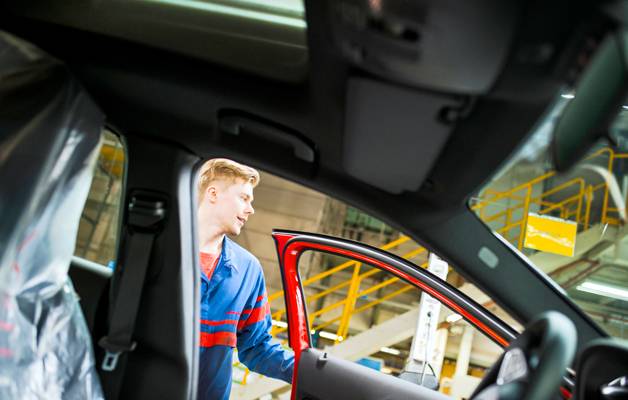
The technology in use at the Valmet Automotive automobile factory in Uusikaupunki is the best there is in the automobile industry. The role of the people who use and develop the technology is even more important.
The automobile factory in the town of Uusikaupunki is an interesting Finnish success story – it is doing well in the international competition. The road to success hasn’t been smooth and won’t be in future either. The sector is demanding, and logistics or large production volumes are not the main strengths of this factory. Its advantages are based on in-house planning, team work and cooperation, appreciating professional skills, and high quality. These are the building blocks that have kept the business going.
A recruiting campaign of all times
At the same time as half of Finland is cutting costs, complaining of the high cost of the work force, and deciding how many workers should be laid off this fiscal year, Valmet Automotive is conducting its biggest recruiting campaign of all times. Since last autumn the number of employees at the car factory has grown by about 800, and by the end of June one thousand more will be hired.
– We announced on radio that A-level motivation is enough. And this is not a question of under-estimating skills or training. But we are Finland’s only automobile factory, and nobody has experience in the kind of know-how needed here, says personnel manager Tomi Salo.
The entire production system – the robots as well as the assembly lines – of the Uusikaupunki automobile factory have been designed by our own experts. And that is a fact known by everyone here.
If the cars were to be assembled in the same way as for instance in Germany, the competition would be too tough for us. Of course comparative analyses are being made continuously to see where we stand.
– We have to compete with the world’s biggest enterprises. The markets, clients and suppliers are abroad. Although our robots are excellent, and we have more of them than anyone else, they don’t guarantee success. Our personnel is the guarantee of our success, Salo emphasizes.
– Although technology advances and the way of working changes, our DNA doesn’t disappear. We have world class know-how on each level of this organization, says Mikael Mäki, communication manager.
We look for people with enthusiasm, interest and readiness to tackle several projects at the same time. The plans and action models applied at the factory have been designed carefully, but the changes going on in the industry are great and rapid.
– A person needs to be flexible and able to change, otherwise they can’t get along here. Multi-skilled people are an asset also in production work. We don’t recruit persons who prefer to work on their own.
“Risk assessments are done to benefit the employees.”

This year our efficient orientation system is being put to the test. Mikael Mäki (left) and Tomi Salo believe that the on-going massive recruitment is a success.
Orientating newcomers to work
How does a stabilized organization cope with such massive recruitment?
– We have long experience in recruiting people and an effective system of orientating new workers, says safety chief Markus Kärkkäinen, HSE (health, safety and environment) Manager.
A lot of work is needed to ensure safety. The factory is huge, but there is no idle space in production. The assembly lines move at their own pace, and 150 forklifts speed along the passage ways. Everyone must be careful, and although the people are busy, there must be no rushing around.
Kärkkäinen sees the safety unit as being a service unit.
– It is our duty to support the business. The doors of the safety unit are always open, and we work together to make this a safe workplace on all levels.
Orientating employees to safety starts already before the work contract has been signed. This includes, among others, a written safety exam and orientating each person to the specific job in question.
Recently a lot of attention has been paid to the assessment of occupational safety risks.
– We do the assessments at the work site, according to Lean thinking. We challenge people and get them committed to safety, says Kärkkäinen.
Lean thinking means that activities that don’t bring added value are eliminated, and the process is improved continuously. The risks are assessed together by the occupational safety delegates and the entire personnel of each work site.
– Top priority is given to informing the personnel about the risks. The risk assessments are not meant for the authorities, nor are they stored in the safe for later use. The assessments are done to benefit the workers, so that they will be aware of the risks in their work.
Everyone can see the TOP5 risk charts many times a day, and supervisors are advised to keep safety issues on the agenda. Improvement suggestions are more than welcome, and employees are also rewarded for making them.
Shared work – a shared future
The aim is to get the job done in one go – to put ergonomics in order, lessen idle time, and design the process so that the order of tasks on the assembly line will be as optimal as possible.
– The best engineers in the field, also on the global scale, are working here for us. We are really proud of our technological applications, which are brilliant innovations. However, according to the principle of continuous improvement, the best innovations very often come from those who do the actual work, Tomi Salo points out.
Finnish high quality still prevails here.
– Our work is of high quality and we take pride in it. We challenge our personnel to think out of the box, to develop their own work and to express their ideas of how things could be done even better.
Services and solutions are being developed continuously. Everyone has the opportunity to improve and develop their work, and good suggestions are rewarded.
The employees of the car factory are capable of making agreements that benefit everyone. Everyone’s goal is to keep the jobs secure. The cornerstones of cooperation are open discourse and local agreements between employer and employees.
– We respect each other, and we also stick to the agreements we make.
Know-how and professional skills lead to quality, quality leads to professional pride, which in turn leads to unique expertise and a unique enterprise.
Opportunities for advancement and specialization
A newcomer can quickly get a good start at the factory. If he shows interest and is motivated, there are plenty of advancement and development opportunities.
– Only the sky is the limit. I can name dozens of persons during the past couple of years who have come to the factory in a group of a hundred workers to listen to the welcoming speeches and to learn one work phase – and quite soon they have ended up as supervisors, team leaders or project engineers, explains the personnel manager.
We want to keep up the positive spiral. Know-how and professional skills lead to quality, quality leads to professional pride, and that in turn to unique know-how – and a unique enterprise.
Professional skills are also given prominence. Not only do managers and sales engineers travel abroad, but on short notice also persons from production go abroad to consult, to train or present ways of operating. At the same time they keep their eyes open for changing trends and new action models.
– People must be ever more skilled and ready to interact with clients and with people in general. We don’t work just among ourselves. We also need to make use of partners and networks.
We had a project last year in which we tested the readiness of people to travel abroad on short notice.
– A plan was drawn up in a few days. We analysed the traveller profiles and checked the requirements of the occupational safety legislation to see what needs to be taken into account when a person goes abroad for a fixed time period, says Markus Kärkkäinen.
He had just come from a military refresher course and was told that he would be leaving for the United States after one week.
– So we made arrangements for the children’s care and other practical things. Many other people were in the same situation. We joined forces and helped each other. It was a huge effort put together in a couple of weeks.
Nearly a hundred people took part in the project, 90% of whom were from the production.
– A surprisingly large number were willing to leave. They were highly skilled workers who had been a long time in the firm. Nevertheless, they were ready to jump into an entirely new situation, Salo points out.
Earlier the supervisor’s role was seen as being more administrative, now the emphasis is on people.
The supervisor’s key role
The production organization has been constructed so that the supervisors have a key role in their own teams. Their job is to lead. During a period of strong growth, leading the personnel and acting in a supervisory role are more important than ever. Also communication and interaction need to be emphasized more. When production starts rolling in three shifts, the interaction between the teams of the same department and the supervisors will face additional challenges.
– It can be made easier, but there are no magic tricks, says communication manager Mäki.
During the next two years, the focus of leadership will be on personnel management.
– Our life unfolds in rapid cycles. Nobody here questions the fact that more employees are hired all the time. In an economic boom we attempt to orientate and train the workers efficiently. Although the number of newcomers is exceptionally high now, extensive recruitments have been carried out earlier as well, says Mäki.
When Tomi Salo came to the factory ten years ago as a training designer, the picture was very different. Porsche took a deep dive, and 600 people were on temporary lay-off. Nevertheless, every employee was trained for two weeks.
– Big volumes, quick action, a lot of people. That’s how we do things.
Earlier the supervisor’s role was seen as being more administrative, now the emphasis is on people. A new kind of training for supervisors starts in May. Instead of seminars, the training consists of modules.
– A couple of hours here, a couple of hours there. This time of year people look forward to summer vacations, but in autumn we concentrate on assessing results and on setting goals. The training also provides support for supervisors.
The supervisor is always also the primary information source.
– Now there are already 2 500 of us. At the end of the year the number will rise to nearly 4 000. The flow of information requires several communication channels within the organization for disseminating information. Communication is being developed continuously, Mikael Mäki tells about the plans for in-house communication.
Intranet reaches the office personnel better. On the production side the team leader checks the news and information bulletins, distributes them to his team and puts on display.
– Big display screens showing the same contents as on intranet have been installed in the cafeteria and a few other places. Some of the intranet information will also be sent to the workers’ smart phones. In that way almost everyone will be reached.
Safety and team spirit
On the production side, occupational delegate Marko Turunen sees to it that also the employer follows safety instructions.
– I can say that right now there is an atmosphere of real drive in the firm. The management is very committed to steer this ship in the right direction.
He adds that a good team spirit is one of the best assets of the factory.
– When we start a work project, we also complete it, and our goal is to do it safely. Our space here is rather limited, so people may trip, or bump their head or hit their elbow.
For example, tripping has been reduced as a result of instructions that were drawn up together: the use of mobile phones in the production hall was prohibited.
– The situation improved markedly. We strongly believe that in a few years our accident statistics will look much better. Both the management and the workers are committed to it.
– We do have challenges, stresses Markus Kärkkäinen.
– Cultural change is the greatest one. The workers and supervisors need to understand that quality, productivity and lead times must be based on safety at all levels. Quality is safety, and safety is quality. Continuous change demands continuous vigilance.
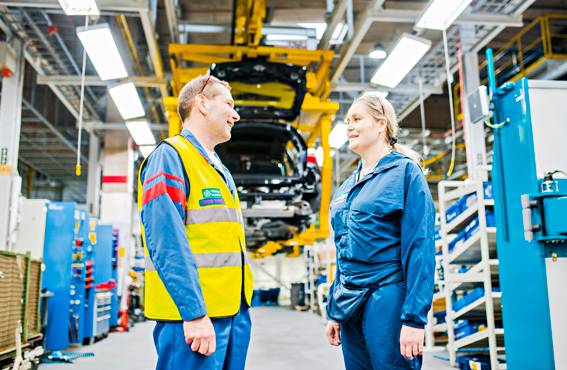
Marko Turunen and Satu Heijari make sure that safety is not just empty words. Their cooperation is based on mutual trust.
Occupational safety was also linked to the personnel’s reward system. The employees are now rewarded for the best improvement ideas.
There is no place for a one-man show at a busy and bustling production plant like this one.
– It is important to understand the meaning of action models and work practices. Whatever the situation, no one here is left alone, says Kärkkäinen. In his opinion the operations are now closer to the Lean model. Unnecessary bureaucracy has been eliminated.
– We do have meetings, and we need them, but an issue can also be promoted when it has been taken up in informal corridor talk.
– And no rule is meant to be a nuisance, it’s for your own good, reminds Satu Heijari, the workers’ deputy trustee at the paint shop. She has been 17 years at the car factory. Her workmates and teams have changed, but the good team spirit hasn’t.
Orientating and guiding new workers is an important part of Satu Heijari’s work.
– Thorough orientating is an important safety factor. It has been developed continuously and in this way safety readiness has been improved. Coping at work is also an essential part of occupational safety. When more work shifts have been added, and people have the opportunity to do overtime work, coping at work must be borne in mind.
– A good team spirit is an asset. Together people are motivated to make their own workplace better, more functional and safer. That is teamwork at its best.
Johanna Sjöberg is responsible for a team of 22 persons consisting of assemblers, substitutes and repair men. She guides and instructs them, making sure that the work proceeds as it should.
– My work varies a lot, that’s the best part. Challenges and rapid situations come up that need to be solved. It’s exciting when everything happens at once. I’m lucky to have a good team that I can count on. I have to be away a lot, so I know that everything works smoothly while I’m gone.
At the moment crowds of new employees are coming in. In the past two weeks six people have come to Sjögren’s team.
– I go over the basics, orientate them to the work, and trust that the substitutes carry on from there. Just today I emphasized that if someone’s hand starts to hurt, they have to report it right away. Then I check to see if the tool is suitable, demonstrate how to use it properly, and show a good working posture. I’ve been an assembler myself, so I know what starts to wear you down.
Sjöberg, who has been nearly 20 years in the factory, says that every day she has come to work feeling good. The right attitude is the answer.


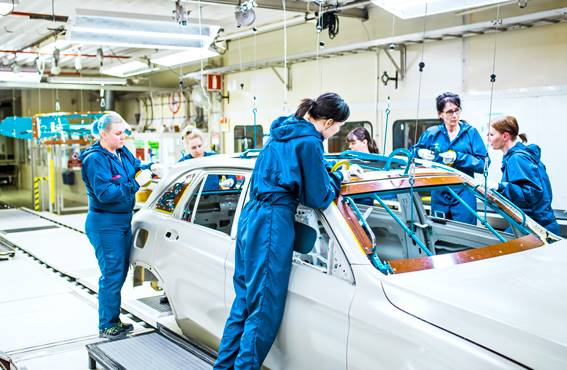

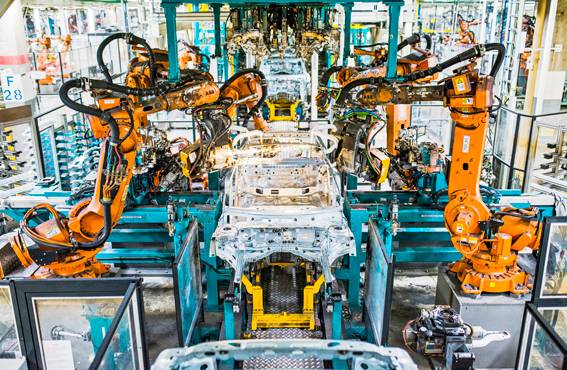

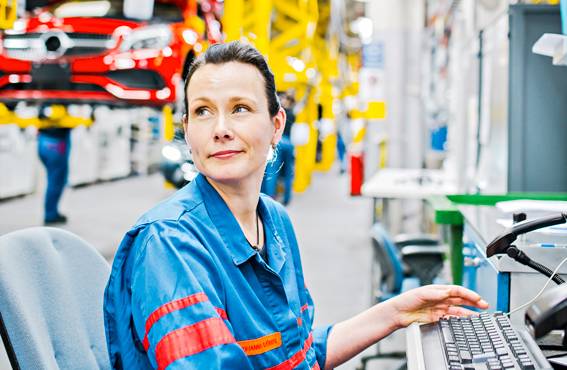
Kommentoi